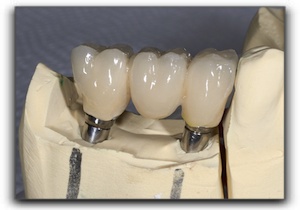
This post looks at the complex process required to fabricate a dental crown. Dental crowns, like those from Staten Island Dental Care, can be constructed with metal, ceramic (porcelain), plastics, or varying combinations of these. We will describe the process used to create a porcelain crown, though the steps are similar to those used for other materials.
As far as beauty goes, today’s high-quality crowns are just as attractive and natural looking as real life teeth. (A crown that looks like a white Chiclet and sticks out like a sore thumb is not a high-quality crown from Staten Island Dental Care.)
When one of our patients needs a crown, a dental assistant makes an impression of all the teeth. The impression is sent to a laboratory where the plaster teeth are separated. The individual tooth mold in need of restoration is scanned into a computer to have the precise dimensions to send to the factory.
The state-of-the-art factory has a computerized machine that will then pour plaster into cylindrical molds, creating blanks. Once hardened, the process of making the tooth from the plaster blanks begins.
The machine then takes the scanned data from the impression and begins sculpting out the contours found in the scan. The finished tooth is not to scale, being 20% to 30% larger than required. This enlargement is to allow for material shrinkage that will later occur.
The machine then dips the plastered tooth into liquid ceramic. The ceramic hardens and gives the tooth a lustrous, natural finish that is indistinguishable from a genuine tooth. The machine then starts a new process of orienting the tooth with others. This time, ceramic powder is poured into new molds over the plaster tooth. The molds are put on a rod and then plunged into a water-filled chamber. Once the chamber lid is closed, water pressure increases, solidifying each ceramic tooth.
The restoration is then chiseled to perfectly match the plastered tooth that is inside. This tooth becomes the ceramic shell of the crown and is easily lifted off the plastered tooth.
This shell, or coping, will then be exposed to a high temperature for increased durability. It also shrinks to the proper size when exposed to the high temperature. Once finished, a plastic replica of the original tooth is created from the computer scan. The new shell is then tested for precise fitting over the tooth.
The shell then leaves the factory for the lab, where layers of colored porcelain are painted on it. A skilled ceramist – an artist in every sense of the word – may apply up to 15 layers of porcelain to perfectly match the variations in the surrounding teeth. This labor-intensive process accounts for much of the cost of a high-quality crown.
The crown is then fired to making the porcelain more condensed throughout. More hand contouring follows, as required, and then is finished with a clear, ceramic gloss.
All of this work results in a terrific crown for one of our patients!
Staten Island Dental Care provides general and restorative dentistry. Make an appointment with us today.
Contact Staten Island Dental Care – Dr. Frederick Hecht:
718-761-5757
Location (Tap to open in Google Maps):
1520 Richmond Ave
Staten Island, New York
10314



